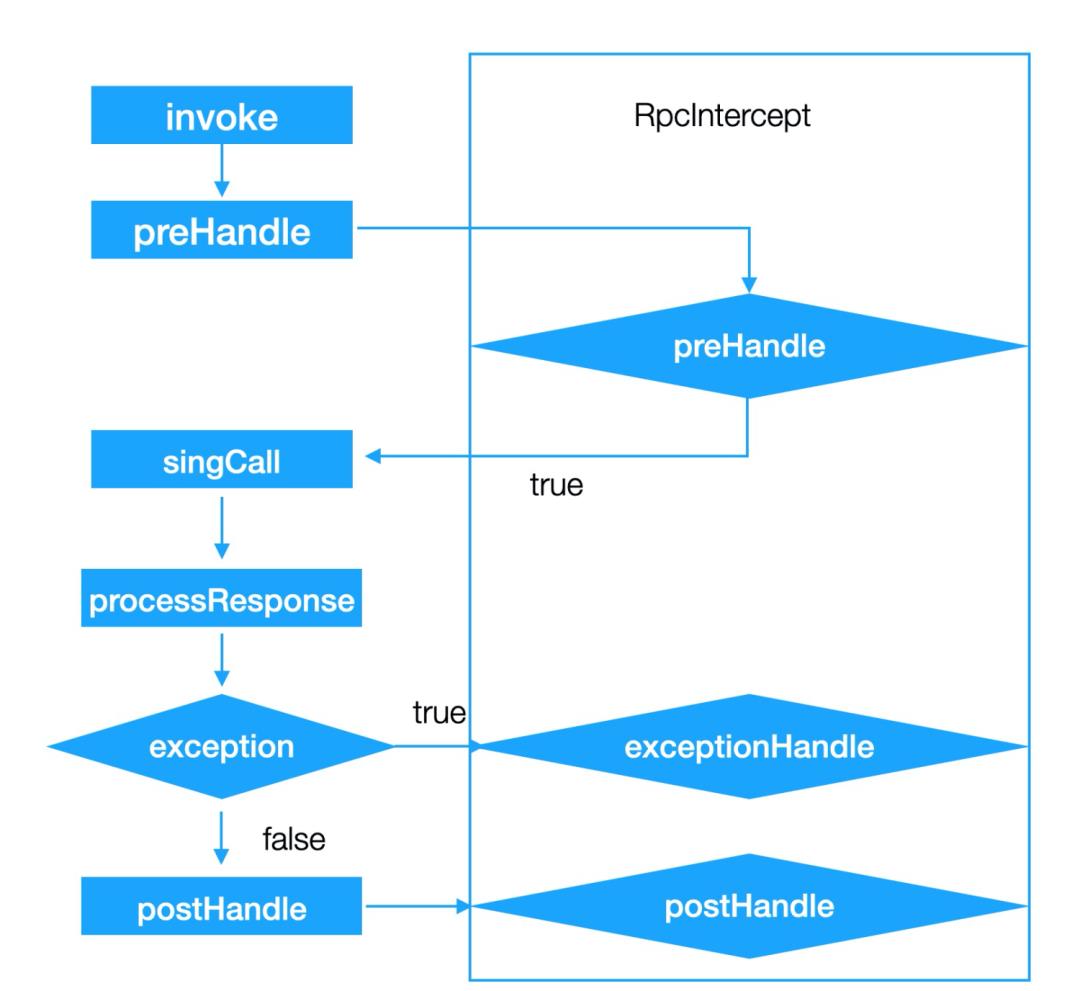mPaaS-RPC 拦截器各种场景下的使用指南
Posted mPaaS
tags:
篇首语:本文由小常识网(cha138.com)小编为大家整理,主要介绍了mPaaS-RPC 拦截器各种场景下的使用指南相关的知识,希望对你有一定的参考价值。
mPaaS 移动网关服务(Mobile Gateway Service,简称 MGS)作为 mPaas 最重要的组件之一,连接了移动客户端与服务端,简化了移动端与服务端的数据协议和通讯协议,从而能够显著提升开发效率和网络通讯效率。
在我们日常运维过程中发现,很多用户在使用客户端RPC组件的时候,有很多不同场景的诉求,比如拦截请求添加业务请求标记,免登,返回结果模拟,异常处理,限流等。
本文旨在介绍通过利用RPC提供的拦截器机制,通过不同实际场景的描述,供业务参考使用。
RPC调用原理
RpcDemoClient client = MPRpc.getRpcProxy(RpcDemoClient.class);// 设置请求GetIdGetReq req = new GetIdGetReq();req.id = "123";req.age = 14;req.isMale = true;// 发起 rpc 请求String response = client.getIdGet(req);
public <T> T getRpcProxy(Class<T> clazz) {LogCatUtil.info("RpcFactory", "clazz=[" + clazz.getName() + "]");return Proxy.newProxyInstance(clazz.getClassLoader(), new Class[]{clazz}, new RpcInvocationHandler(this.mConfig, clazz, this.mRpcInvoker));}
RpcService rpcService = getMicroApplicationContext().findServiceByInterface(RpcService.class.getName());rpcService.addRpcInterceptor(OperationType.class, new CommonInterceptor());
拦截器原理

preHandle场景
1. 全局添加业务自定义请求header
@Overridepublic boolean preHandle(Object proxy,ThreadLocal<Object> retValue,byte[] retRawValue,Class<?> aClass,Method method,Object[] args,Annotation annotation,ThreadLocal<Map<String, Object>> threadLocal)throws RpcException {//Do something...RpcInvocationHandler handler = (RpcInvocationHandler) Proxy.getInvocationHandler(proxy);handler.getRpcInvokeContext().addRequestHeader("header", "headerCustom");return true;}
2. 阻断当前请求rpc流程
@Overridepublic boolean preHandle(Object proxy,ThreadLocal<Object> retValue,byte[] retRawValue,Class<?> aClass,Method method,Object[] args,Annotation annotation,ThreadLocal<Map<String, Object>> threadLocal)throws RpcException {//Do something...String operationType = getOperationType(aClass, method, args);if ("operationType1".equals(operationType)) {boolean isLogin = false;if (!isLogin) {Handler handler = new Handler(Looper.getMainLooper());handler.post(new Runnable() {@Overridepublic void run() {Toast.makeText(LauncherApplicationAgent.getInstance().getApplicationContext(),"当前未登录,请登录", Toast.LENGTH_SHORT).show();}});// 返回给上层调用登录失败的异常,上层做业务处理throw new RpcException(RpcException.ErrorCode.CLIENT_LOGIN_FAIL_ERROR, "login fail.");}}return true;}private String getOperationType(Class<?> aClass, Method method, Object[] args) {if (aClass == null || null == method) return "";OperationType operationType = method.getAnnotation(OperationType.class);return operationType == null ? "" : operationType.value();}
postHandle场景
1. 拦截接口返回
@Overridepublic boolean postHandle(Object proxy,ThreadLocal<Object> threadLocal,byte[] retRawValue,Class<?> aClass,Method method,Object[] args,Annotation annotation) throws RpcException {//Do something...// 场景:修改服务端返回的数据,比如mock数据,或者修改服务端数据String operationType = getOperationType(aClass, method, args);LoggerFactory.getTraceLogger().debug(TAG, "postHandle:" + operationType);if ("operationType1".equals(operationType)) {String value = JSON.parse(retRawValue).toString();LoggerFactory.getTraceLogger().debug(TAG, "postHandle 原始返回" + value);String mockData = "{"img":"imgPath","User":{"name":"我是mock的数据","age":18}}";Object mockObj = JSON.parseObject(mockData, method.getReturnType());threadLocal.set(mockObj);return true;}return true;}private String getOperationType(Class<?> aClass, Method method, Object[] args) {if (aClass == null || null == method) return "";OperationType operationType = method.getAnnotation(OperationType.class);return operationType == null ? "" : operationType.value();}
exceptionHandle场景
1. 异常统一处理
@Overridepublic boolean exceptionHandle(Object proxy, ThreadLocal<Object> retValue, byte[] bytes, Class<?> aClass, Method method, Object[] objects,RpcException rpcException, Annotation annotation) throws RpcException {String operationType = getOperationType(aClass, method, objects);if (RpcException.ErrorCode.CLIENT_LOGIN_FAIL_ERROR == rpcException.getCode()&& "operationType1".equals(operationType)) {// 1. 去免登hasLogin = true;// 2. 免登后在帮上层重发请求,免登操作对上层业务无感知try {LoggerFactory.getTraceLogger().debug(TAG, "exceptionHandle. Start resend rpc begin " + operationType);// 重发请求Object object = method.invoke(proxy, objects);retValue.set(object);LoggerFactory.getTraceLogger().debug(TAG, "exceptionHandle. Start resend rpc success");return false;} catch (Throwable e) {LoggerFactory.getTraceLogger().error(TAG, "resend rpc occurs illegal argument exception", e);throw new RpcException(RpcException.ErrorCode.CLIENT_HANDLE_ERROR, e + "");}}return true;}
H5场景
1. 获取H5请求的接口名称和入参
var params = [{"_requestBody":{"userName":"", "userId":0}}]var operationType = 'alipay.mobile.ic.dispatch'AlipayJSBridge.call('rpc', {operationType: operationType,requestData: params,headers:{}}, function (result) {console.log(result);});
public boolean preHandle(Object o, ThreadLocal<Object> threadLocal, byte[] bytes, Class<?> aClass, Method method, Object[] objects, Annotation annotation, ThreadLocal<Map<String, Object>> threadLocal1) throws RpcException {String operationType = getOperationType(aClass, method, objects);if ("alipay.client.executerpc".equals(operationType)) {// H5的rpc名称String rpcName = (String) objects[0];// 入参String req = (String) objects[1];LoggerFactory.getTraceLogger().debug(TAG, "operationType:" + rpcName + " " + req);} else {// Native的rpc}LoggerFactory.getTraceLogger().debug(TAG, "operationType:" + operationType);return true;}

- END -

以上是关于mPaaS-RPC 拦截器各种场景下的使用指南的主要内容,如果未能解决你的问题,请参考以下文章